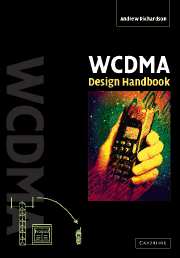Book contents
- Frontmatter
- Dedication
- Contents
- Preface
- Acknowledgements
- List of abbreviations
- 1 Introduction
- 2 WCDMA in a nutshell
- 3 Spreading codes and modulation
- 4 Physical layer
- 5 RF aspects
- 6 Chip rate processing functions
- 7 Symbol rate processing functions
- 8 Layer 2 - medium access control (MAC)
- 9 Layer 2 - RLC
- 10 PDCP and BMC protocols
- 11 Layer 3 - RRC
- 12 Measurements
- 13 NAS
- 14 Idle mode functions
- Appendix
- References
- Index
8 - Layer 2 - medium access control (MAC)
Published online by Cambridge University Press: 05 October 2013
- Frontmatter
- Dedication
- Contents
- Preface
- Acknowledgements
- List of abbreviations
- 1 Introduction
- 2 WCDMA in a nutshell
- 3 Spreading codes and modulation
- 4 Physical layer
- 5 RF aspects
- 6 Chip rate processing functions
- 7 Symbol rate processing functions
- 8 Layer 2 - medium access control (MAC)
- 9 Layer 2 - RLC
- 10 PDCP and BMC protocols
- 11 Layer 3 - RRC
- 12 Measurements
- 13 NAS
- 14 Idle mode functions
- Appendix
- References
- Index
Summary
MAC introduction
The MAC layer is the lower part of WCDMA layer 2 protocol architecture. At the input to the MAC there are logical channels and at the output there are transport channels. The logical channels define ‘what’ the information is that is being transported, whilst the transport channels define ‘how’ the information is transported. One of the prime functions of the MAC, therefore, is to map a specific logical channel onto the appropriate transport channel. We will see later that this mapping can change dynamically as the characteristics of the network or the user vary (for instance due to a rise or fall of the loading in the network).
This chapter starts by considering the logical channels that enter the MAC, their structure and uses, and also transport channels that exit the MAC, their structure and uses. When we consider the architecture of the MAC, we see that it comprises a number of component parts to reflect its distributed nature within the UTRAN. The functions and services provided by the MAC include items such as random access procedure and transport format selection control, and the mapping and switching between logical and transport channels. To fully understand the function of the MAC we then explore in greater detail some of the key operations it provides, including the random access procedure, the control of CPCH and the TFC selection in the uplink within the UE. We start this first section with an introduction to the logical channels that the MAC provides for the transportation of higher layer data, and review the transport channels considered in earlier chapters.
- Type
- Chapter
- Information
- WCDMA Design Handbook , pp. 248 - 299Publisher: Cambridge University PressPrint publication year: 2005



